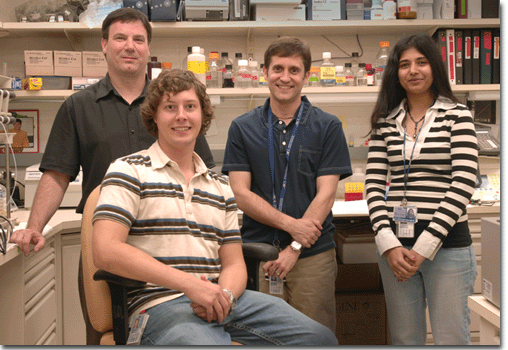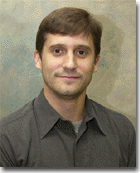| Biography: : Dr. David Wilson received a Bachelor of Arts degree in both Biology and Political Science from Bucknell University in 1989. He completed his Ph.D. work in 1993 at Loyola University of Chicago, Stritch School of Medicine, as part of the Molecular Biology Program. Dr. Wilson performed his postdoctoral research training at the Harvard School of Public Health until 1997, when he became a Senior Biomedical Scientist at Lawrence Livermore National Laboratory in the Biology and Biotechnology Research Program. While at Livermore, he was also an adjunct faculty member in the Radiation Oncology Department at the University of California Cancer Center - Sacramento. Dr. Wilson started at NIA in 2002. |
| Oxidative DNA Damage Repair - Molecular Mechanisms and Role in Age-related Disease: Reactive oxygen species are formed as by-products of aerobic respiration or following exposure to certain environmental contaminants. These products react with lipids, proteins and nucleic acids, and are thought to contribute to aging and age-related disease by promoting the gradual accumulation of macromolecular damage and consequent cellular dysfunction or cell death. Oxidative DNA damage - such as 8-oxoguanine, abasic (AP) sites, and complex single-strand breaks (SSBs) - poses a mutagenic and cytotoxic challenge to the cell. The major system for correcting such damage is base excision repair (BER). My laboratory has been involved in elucidating the molecular pathways of BER and, more recently, in determining the contribution of core and auxiliary BER proteins to disease manifestation, therapeutic agent responsiveness, and aging. The current goals are as follows: |
| I. Delineate the contribution of APE1 (and BER) to DNA damage responses and disease susceptibility. APE1 is the major human AP endonuclease, and operates centrally to the BER process. We are establishing stable shRNA knockdown cell lines that will allow us to strategically dissect out the precise contribution of each function of APE1 (i.e. its nuclease activity, redox regulatory role, etc.). Using a dominant-negative form of the APE1 protein (termed ED), we are also evaluating the contribution of the BER pathway to clinical DNA-damaging agent resistance. Finally, we are assessing the potential relationship of reduced BER capacity to disease development using established and in-development biochemical repair assays and defined population sets. We hypothesize that APE1, and BER more generally, plays a critical role in dictating cellular responsiveness to genotoxic insults and susceptibility to disease manifestation, particularly in the face of certain environmental exposure(s). |
| II. Determine the molecular involvement of CSB in the repair of endogenous DNA damage. Cockayne syndrome (CS) is an autosomal recessive disorder, characterized by growth failure, premature aging symptoms, neurological abnormalities, and cutaneous photosensitivity, but no increased cancer incidence. CSB harbors seven helicase-like ATPase motifs found within the SWI2/SNF2 superfamily of chromatin remodeling proteins, and interacts with a number of BER protein factors, yet its precise biochemical and cellular functions remain unclear. We are examining the in vitro activities of CSB on key DNA and RNA transaction intermediates, and aim to elucidate the contributions of the unique N- and C-terminal portions of the protein that likely impart functional specificity. We hypothesize that CSB operates as an auxiliary protein in BER by inducing topological changes in nucleic acid targets and directing specific protein interactions, and that these functions are critical to the manifestation of the inherent disease pathologies associated with CS patients. |
| III. Elucidate the role of XRCC1 in aging and disease susceptibility, namely neurodegeneration and cancer. XRCC1 is a non-enzymatic scaffold protein that operates to coordinate SSB repair (SSBR), a sub-pathway of BER vital for resolving oxidative DNA strand breaks. Functional interactions with proteins that are defective in spinocerebellar ataxias (i.e. TDP1 and Aprataxin) imply a connection between XRCC1 (and SSBR in general) with neurodegenerative disease. We are currently assessing the role of XRCC1 in non-dividing neural cells using cell culture models and in age-related pathologies using heterozygous mice; we will next evaluate the effect of XRCC1 haploinsufficiency on neurodegeneration and cancer proneness following defined insults. The contributions of XRCC1 to DNA damage responses, genomic stability, and telomere maintenance will also be evaluated in dividing human cell lines using chronic shRNA knockdown strategies. We hypothesize that defects in SSBR will be more deleterious to non-dividing cells than dividing cells, because dividing cells repair SSBs not only by SSBR, but also by replication-mediated homologous recombination. |
- PubMed: Search for listing of Dr. Wilson's publications.
|
 |
| Unit on Structure and Function in Base Excision Repair (left to right). Row 1: Brian Berquist, row 2: Dan McNeill, David Wilson, Avanti Kulkarni. |




